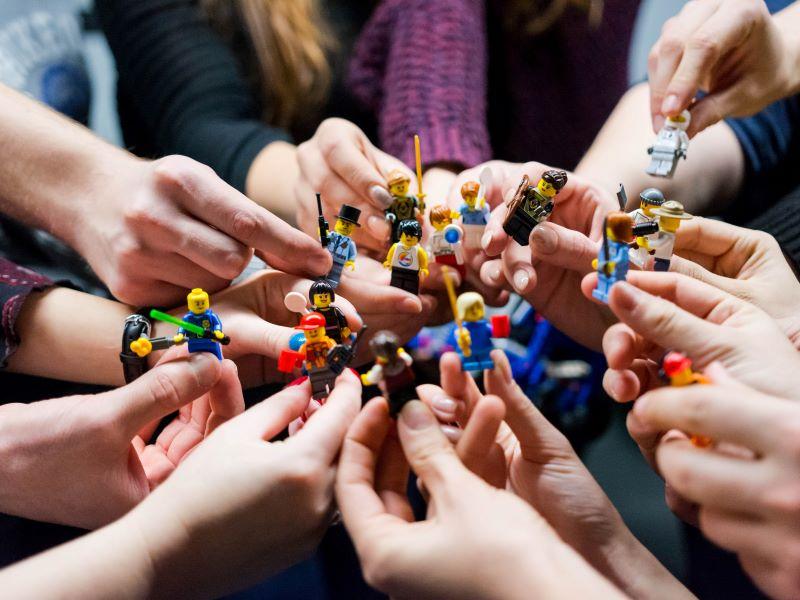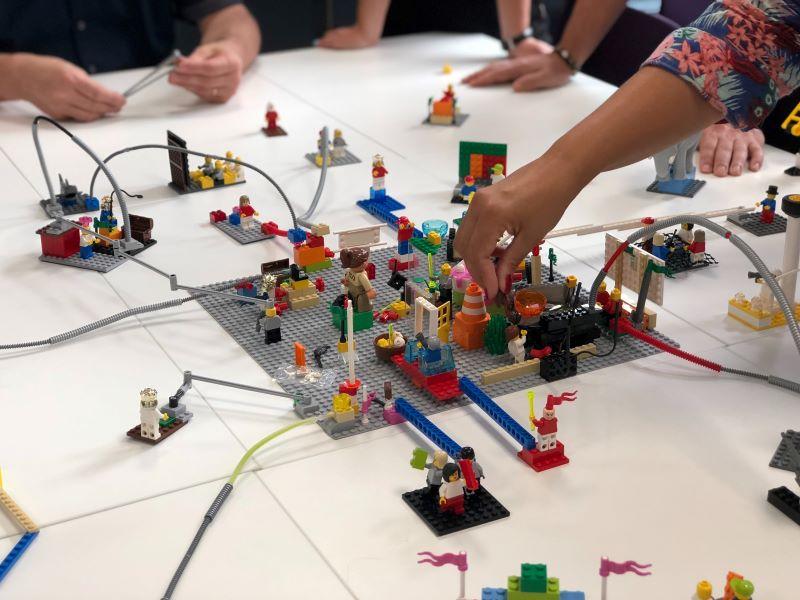LEGO® Serious Play® (LSP) was originally designed in the 1990s for use in the business world as a means of facilitating collaborative brainstorming sessions. The LEGO bricks deflect attention from the person making a point, and focus attention on the model being described, helping to create a more open and democratic process in which people feel comfortable thinking more innovatively and creatively. Different ideas can be critiqued or discarded without anyone feeling personally attacked.
While businesses often use LSP to converge on an agreed concept or game plan, scholarly discussions at university might instead prioritise plurality and divergence. Just as LEGO is itself a flexible tool, so, too, is LSP suited to a range of uses at universities, including:
Icebreakers and team-building activities
LEGO provides a fun and light-hearted way to overcome social barriers. Facilitators might challenge students to build models showing their ideal superpower or their favourite topic of study within the discipline. These visuals could be displayed during introductions and used to help students remember names.
Students might be placed into groups and challenged – for example, to build a tower in a set period of time. Those with the tallest tower win the competition, but everyone benefits from a greater feeling of cohesion.
Activities can be used among students who already know each other to support and improve well-being by introducing playfulness and joy into the curriculum and offering students an opportunity to (re)connect. For instance, students might build models of a favourite shared learning or extracurricular experience and then compare and contrast, appreciating how different models capture different aspects of the same event.
Sharing a diversity of lived experiences
LSP offers a means of platforming and amplifying diverse voices in the classroom – something that may be particularly appealing to those undertaking decolonisation or antiracism work. Instructors might use prompts such as “build a model showing your values”, “build a model showing ethical research in our field” or “build a model showing an equality/diversity/inclusivity issue that needs to be tackled in this discipline”. With the focus more on the models than the students, they may feel more comfortable expressing their personal views and experiences. The striking visuals are memorable, encouraging prolonged reflection long after the session has ended.
LEGO models can also be used to share ideas about how to tackle particular problems – for example, timekeeping, interpersonal relationships or mental health challenges. When students engage with LSP to discuss these issues, they receive not only the benefit of peer mentoring but also a strong sense of community support. And both encourage resilience.
Comparing or contrasting understanding of tricky ideas
A diversity of ideas is interesting in the context of more discipline-specific concepts – especially those that are contested or undefined. In business, for example, the conversation might explore the ideal governance structure; in biology, the discussion might focus on what constitutes a “species”. Each student can share their own model, and then, using the LSP technique, the group could build a collaborative model uniting their ideas into a single agreed vision.
Ideation for assignments and education goals
Brainstorming is as useful in higher education as it is in the business world from which LSP emerged; this is particularly true in the context of group projects. Group members can use LEGO to ponder any aspect of their work, including topics, outputs or processes.
LEGO can also be used for education-related ideation generally – for example, to help visualise learning and employment goals. Students can do this independently and also be given opportunities to share, such as in tutorials, and teach or inspire their classmates.
Gamification of revision for assessments
Revision can be made more fun via gamification with LEGO. Students can take turns building models to represent key concepts, and then peers can try to guess what the models are communicating.
For example, “natural selection” might be conveyed by creating two similar LEGO habitats and showing a brick species disappearing from the second because it is no longer fit for that environment.
It is challenging to boil down a concept to its most essential elements and then communicate those points to someone else. Therefore, this “bricks and mortar”-style revision technique supports deeper learning and better retention of knowledge.
Building blocks of reflection
This is just a sample of the ways in which playing with LEGO can make learning more active, engaging and enjoyable. Many uses deviate from the original LSP technique but are nevertheless still in the spirit of that method, incorporating elements of the approach.
If LSP is introduced early on – for example, during induction or the first week of classes – then students can be given a personal set of bricks that they are encouraged to reuse over the course of their university journey, employing LEGO adaptively to achieve the learning goals at hand.
In this way, they can build their knowledge not just metaphorically but physically as well.
Caitlin Kight is manager of academic development and skills and Holly Henderson is a senior lecturer, both at the University of Exeter.




comment